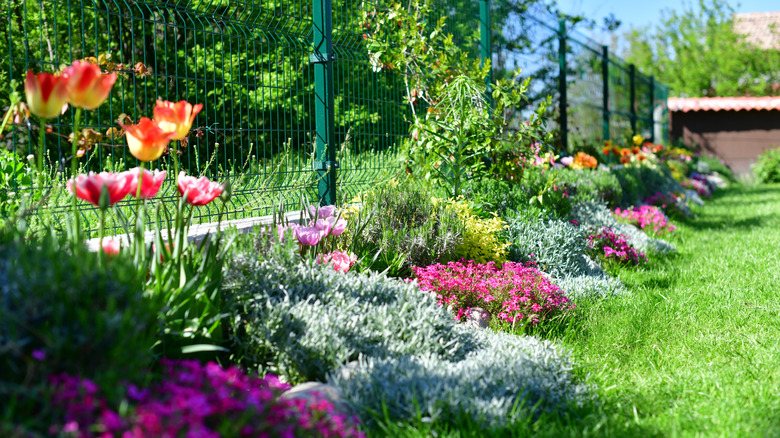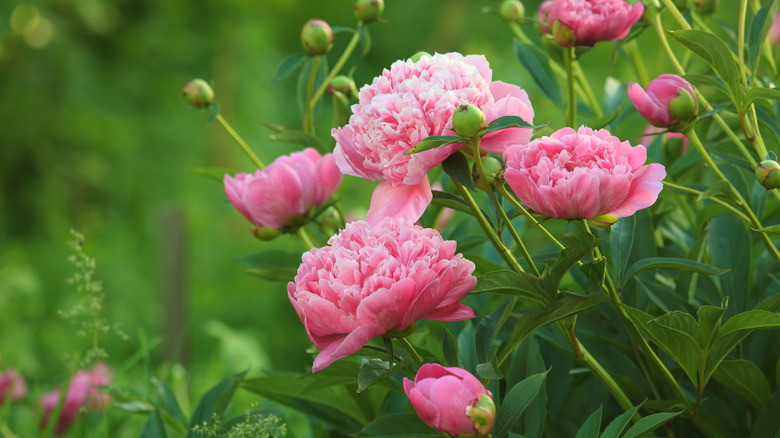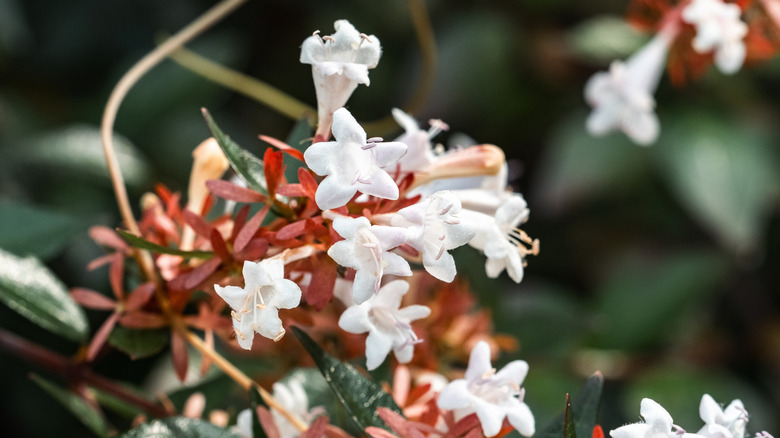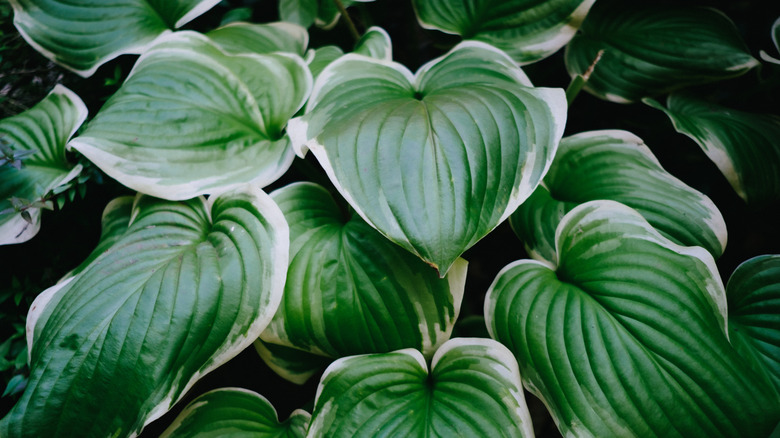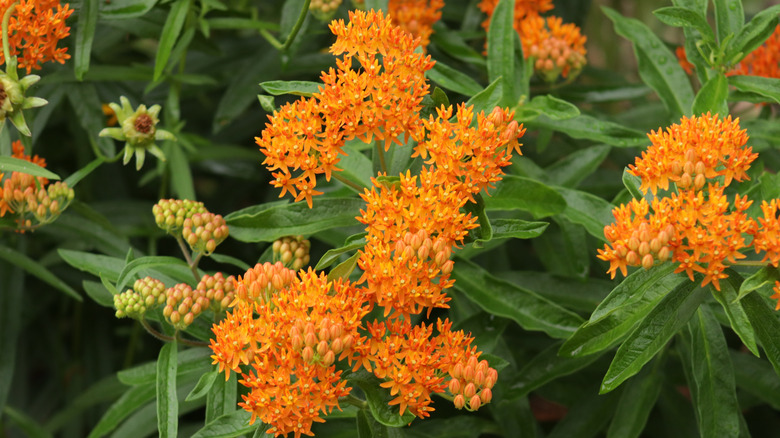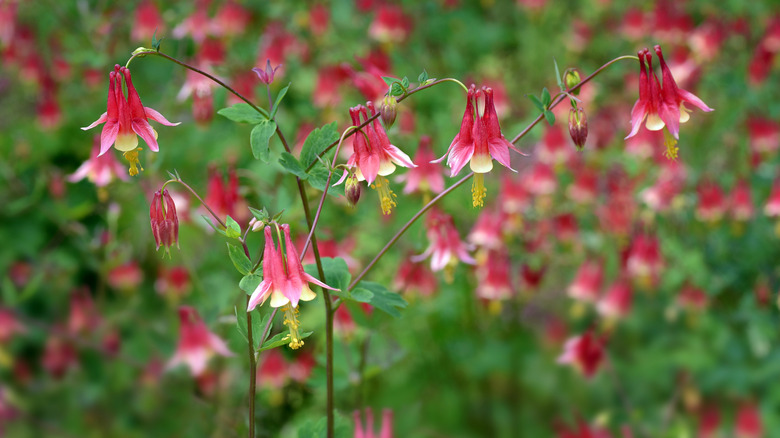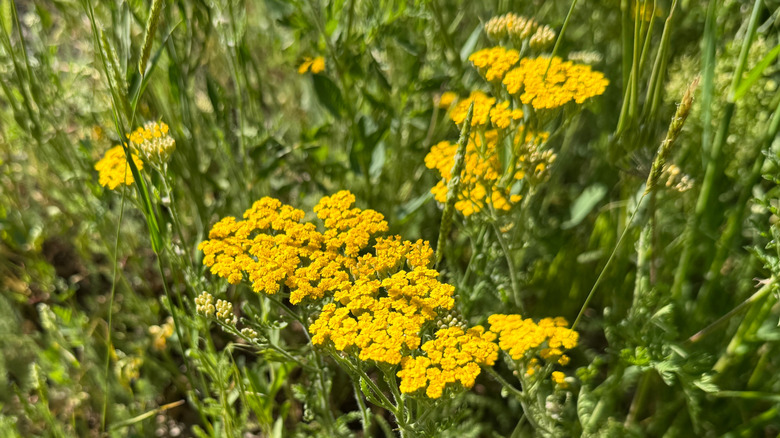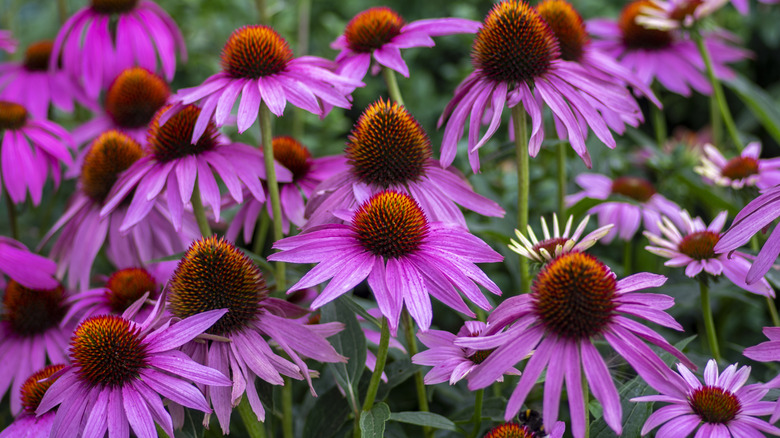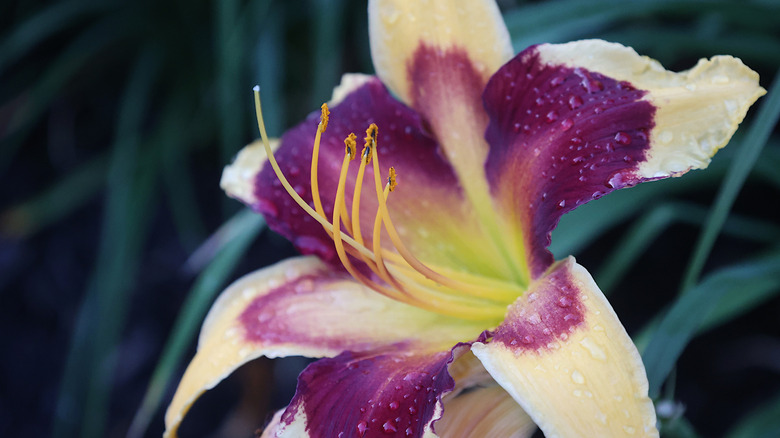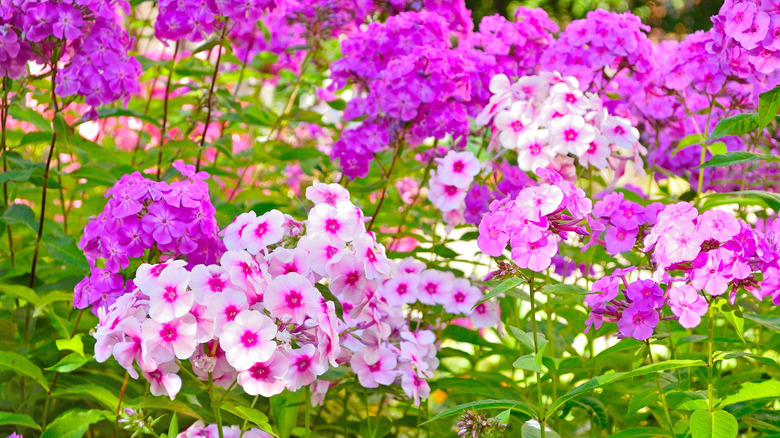12 Perennial Plants That Will Bring Timeless Beauty To The Garden For Years
We may receive a commission on purchases made from links.
Gardening trends seem to come and go, but the appeal of a garden that's designed around timeless beauty is, obviously, everlasting. While it's fun to follow the occasional TikTok trend, creating a thoughtful, charming gardenscape will endure over time and save you the headache of needing to redo outdated garden trends. And while we love us some annuals, planting lasting perennials lets you establish your garden design for the long haul, like a gift that keeps on giving.
But, look, choosing the right perennials isn't easy, because you've got to find the right balance between longevity, resilience, and eye candy. So, we've done the heavy lifting for you and picked 11 of our favorite perennial garden plants that give off that classic look — and won't die back after a few seasons. Whether you're looking for lush foliage, iconic blooms, or just need plants with long-term low-maintenance needs, we'll break down why we love each plant so much, as well as cover the average life expectancy you should plan for if you keep the plant happy and healthy.
Peonies can live up to 50 years or more
There's a reason you'll find peonies on every cottagecore Pinterest board: Their look is absolutely timeless. Those big, poofy blooms that come in pretty much every shade of red, pink, and white bring a sort of lush, romantic vibe to gardens right as summer gets going that never goes out of style. Plus, a happy peony is sure to be with you for the long haul, because they can easily live for 50 to 100 years in the same spot, making them a garden investment you can truly enjoy for a lifetime.
So, how do you make sure your peonies stay with you through thick and thin? It all comes down to where you plant them and having a little patience. First, don't put those beauties in the shade; peonies are made for the sun and need at least six hours of direct sunlight to produce those iconic blooms. Make sure wherever they're going is as permanent as possible, because peonies hate to be moved. Also, plant them shallow; the eyes on the roots need to stay slightly less than 2 inches deep in the soil. Anything deeper will give you a nice green bush, but no flowers. Also, though we said not to move them, it's okay if you dust off a few inches of soil if you've already planted your peonies, but might've gone too deep. To make sure you're not creating a disturbance, you can wait until the fall when the plant is dormant. Finally, don't worry if the first few years aren't going the way you hoped; peonies tend to take one or two years before they'll flower.
Lenten roses can bloom for up to three months and live as long as 20 years
You know that dreary stretch in late winter when you're convinced spring will never arrive? The Lenten rose (Helleborus orientalis) is here to save the day. Lenten roses aren't actually roses, but their flowers come in these gorgeous, dusty shades of purple, maroon, white, or even super-goth black if you're okay with a cultivar, and look ultra-elegant against a bleak landscape. Lenten roses are a flower Martha Stewart loves and also total troopers, pushing their flowers out even when there's still snow on the ground. And unlike other early spring bloomers that tend to be short-lived, not only can these flowers can last for up to three months, but a single plant can live for 20 years, slowly creating a whole colony bursting with color during winter's last grasp. Note: This only applies to acaulescent varieties (which don't have stems). Caulescent, stemmed types only last for a few years, however they easily propagate themselves from seed.
Honestly, the best thing about Lenten roses is that they pretty much thrive on neglect once they're established. They do have one major request: Don't plant them where they're susceptible to a hot, baking sun. They love the shade and would prefer to stay somewhat protected from the wind, so choose a sheltered spot that doesn't get blistering sun to ensure your Lenten roses stay happy and live a long life. Once they're planted, the only real chore you'll have is snipping off last year's tattered-looking leaves in late winter to make way for the new show. Oh, and maybe the biggest win of all? They're deer- and rabbit-resistant.
Glossy abelia is tough as nails and can live up to 30 years
Every garden needs a few plants that are just effortlessly good-looking without being the main character, and that's the glossy abelia (Abelia x grandiflora). Its whole vibe is just relaxed and pretty, with branches that stretch out and leaves that are so shiny they almost look artificial. But the real reason we're obsessed with it is its flowers. From late spring to fall, it's covered in tons of little, sweet-smelling pinkish-white flowers that bees absolutely love. This isn't some fleeting romance, either; a single shrub is ridiculously hardy and can hang out in your garden for 30 years or more.
So, what does a plant this tough actually need from you? Honestly, not much; glossy abelia is truly one of the most low-drama plants around. Give it a spot with a decent amount of sun to get the best flower show, but it'll be perfectly fine with a little shade if that's the best you've got. It's not picky about soil, just as long as it's not sitting in a swamp or saline ground. The only thing you'll probably want to do is give it a good trim in late winter to keep it looking fresh. Just reach in and cut out a few of the oldest, thickest stems at the base of the plant. Whatever you do, don't shear it into a tight ball — that just ruins its naturally graceful shape.
Hostas have legendary foliage and can live for 30 years or more
If you have a shady spot in your yard where grass refuses to grow, the hosta is about to become your new best friend. Their timeless look isn't about flowers (though they will throw up the occasional tall shoot of delicate blooms), but instead about their absolutely legendary foliage. Hostas come in a wide variety of shapes and sizes, with leaves in every shade of green, blue, gold, or streaked in creamy white. They create a lush, textured carpet that instantly makes a garden look established and expensive. Best of all, they are incredibly long-lived. A single plant can easily thrive for 30 years or more, getting bigger and better each season.
Successfully caring for hosta plants doesn't take much effort, but they are divas about one thing: shade. While a little gentle morning sun is fine, their big, beautiful leaves will scorch and burn in the hot afternoon sun, so keeping them protected is key. To keep the plant vigorous for decades and prevent the center of the clump from dying out, plan on digging them up and dividing them every 3 to 5 years. Besides being good for the plant's health, it's also the perfect way to get free plants to fill out your garden or share with friends.
Daffodils are a delight to see after long winters and can live for nearly a century
Is there any better sign that winter is finally over than seeing the first cheerful daffodils (Narcissus)? Their iconic, trumpet-shaped flowers announce spring's arrival, bringing a much-needed dose of sunny vibes. But their real magic lies in their longevity. Don't just take our word for it; Steve Eisenhauer, Regional Director of Protection and Land Stewardship for Natural Lands, says he's found colonies that are around 80 years old. This is possible because daffodils are masters at "naturalizing" — the original bulbs you plant multiply underground, creating new bulbs year after year until a small patch becomes an impressive drift that can last for generations.
To get a daffodil colony started, all you need to do is plant the bulbs in the fall in a spot that gets a decent amount of sun. And if you want them to multiply and come back for decades, there's one clever trick for growing daffodils that's guaranteed to make them super prolific: After they're done blooming, wait at least six weeks and let the foliage die back on its own. It's tempting to cut the messy-looking leaves down, but those leaves are working hard, acting like solar panels to transmit the energy the bulb needs for next year's flowers. Cut them too soon, and you risk getting no blooms next year.
Butterfly weed grows slowly but can make your garden pollinators happy for up to 10 years
If you want to get serious about helping monarch butterflies — and get a killer pop of "traffic-cone orange" in your garden — then you need to get to know butterfly weed (Asclepias tuberosa). However, and this is a big however, this plant is not about instant gratification. It can take up to four years for it to really settle in and start producing those amazing clusters of flowers. But it is so worth the wait, because once butterfly weed hits its stride, this thing is a tough-as-nails workhorse that comes back bigger and better each summer for up to 10 years.
The secret to making butterfly weed happy enough to stick around that long is to be mean to it. Seriously. It hates rich, fancy soil and won't thrive around helicopter plant parents who give it too much water. It wants to bake in the full, hot sun in that dry, sandy, forgotten patch of your yard. It puts down a taproot the size of a carrot, which is great for surviving droughts, but it means you have to pick its forever home on day one because it may not survive being moved. So just give it sun and neglect, and it will thank you by becoming the favorite neighborhood restaurant for every butterfly around.
Eastern red columbine may only live for 4 years, but it self-seeds for decades
If you want to see hummingbirds zipping around your yard (and who doesn't?), plant some eastern red columbine (Aquilegia canadensis). Columbines have these gorgeous red-and-yellow flowers that bring a delicate, woodland vibe to the garden for around a month in the early spring. While an individual plant will only live for about four years, it's so good at making babies that this doesn't even matter. The plant drops seeds everywhere, meaning your "patch" of columbine will basically live forever, as new plants are always taking over for the old ones.
The joy of planting a native like A. canadensis is that its care requirements are nearly nothing. Find a spot that replicates its native forest zones and gets a little bit of shade, especially in the afternoon, and has rich, moist soil. Once you've covered that part, your main job is to fight the urge to be a tidy gardener. You must let the flowers fade and form their little seed pods. Once those pods have dried and dropped their seeds, the mission for next year is accomplished, and you'll be setting the stage for new plants to keep on popping up, practically indefinitely.
Yarrow can produce flowers for 5 years if it's happy
Yarrow (Achillea millefolium) has an awesome textural contrast that makes it stand out in gardenscapes. Its foliage is super delicate with fern-like leaves, but then it's got these big, flat-topped flower clusters that pollinators treat like a personal landing pad. It's a workhorse flower, and, according to a study published in the Journal of the American Society for Horticultural Science, can keep producing flowers for up to five years, which is a fantastic run for a perennial that blooms for several weeks..
Like a few other tough plants on our list, the secret to long-lived yarrow is to avoid killing it with kindness, because it thrives under neglect. This plant wants to be in the full, hot sun, and likes its soil well-draining, but doesn't care much about its quality. The most important trick to keep a plant vigorous for its full lifespan is to divide it every three years or so. When the clump gets too big, the center can die out. Just dig the whole thing up in the spring or fall, split it into smaller pieces with a spade, and replant.
Coneflower is a classic summer staple that can live for up to 10 years
In our opinion, you can't really have a classic summer meadow garden without a patch of coneflowers (Echinacea purpurea). Its timeless, daisy-like flowers push out all summer long. But if you want a coneflower that lasts for a 10-year stretch, then you have to stick with the classic versions. While there are stunning hybrid varieties of coneflowers you could grow, all those new, flashy-colored hybrids are notorious for being short-lived divas. The OG native coneflowers are the tough, reliable blooms that will come back for years.
Coneflowers are incredibly resilient and adaptable, and as long as you plant them in a spot that gets full sun, they're happy. They aren't picky about soil and can handle heat and drought like a champ. The main chore to keep them vigorous for their full lifespan is to dig up and divide the clump every four years or so, which keeps them from getting too crowded and losing their magic. Also, delay pruning after they're done blooming. Not only will you'll get to watch goldfinches come and feast on the seeds – the ones that don't get eaten will readily germinate to reseed new plants.
Daylily is the ultimate plant-it-and-forget-it flower and can live for 20 years or more
While we love getting our hands dirty, sometimes you just want a plant that will give you a ton of flowers without needing you to get up off the couch. That's the daylily (Hemerocallis), and the name gives away its secret: each flower lasts just one day. But who cares? The plant just keeps cranking them out for weeks. Daylilies are ridiculously tough and so vigorous that a single clump will need to be divided every few years. That's how you know you have a plant that can stick around for decades — it's practically unstoppable. Backing up their reputation as a long-lived perennial, there are anecdotal reports from gardeners of daylily patches that could be well over 30 years old.
Daylilies will give you the most flowers if you plant them in full sun, but they're not going to die if they get a little shade. They like their soil to be slightly acidic, but adapt pretty well to other pH levels if the soil has a good amount of organic material. If you're feeling like you need to balance your couch-sitting with a little maintenance (no judgment), you can cut them back to the soil level to keep things tidy once the bloom season is over and help your daylilies rebloom. To get the maximum longevity out of your gorgeous daylilies, aim to divide the clumps every 3-4 years.
Phloxes make fantastic garden additions because they're hardy and can live for decades
Garden phlox (Phlox paniculata) is the quintessential mid-summer flower, forming huge, cone-shaped clouds of fragrant blooms in shades of pink, purple, and white. They have a sweet scent and the big, showy flower heads make a statement in the back of a garden border. A healthy clump is a reliable performer that will come back year after year, often lasting for decades and getting more impressive each season.
To keep your garden phlox happy for that multi-decade run, it will need at least partial sun and moist, but well-draining, soil. They don't like to dry out completely, so a layer of mulch to keep the soil moist is a big help. But the one trick that makes the biggest difference — and helps prevent powdery mildew — is to thin the plant out in the spring. Once it has a bunch of stems about six inches tall, select the five or six strongest ones and snip all the others down to the ground. This gives the plant the air circulation it needs to help ward off powdery mildew. While powdery mildew might not directly kill phlox, it can zap plant vigor over time.
